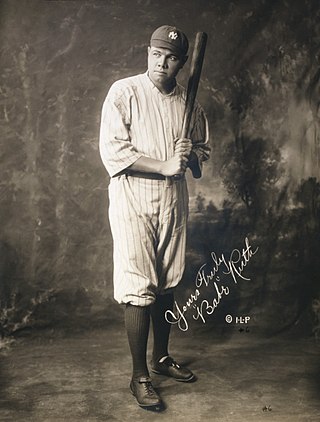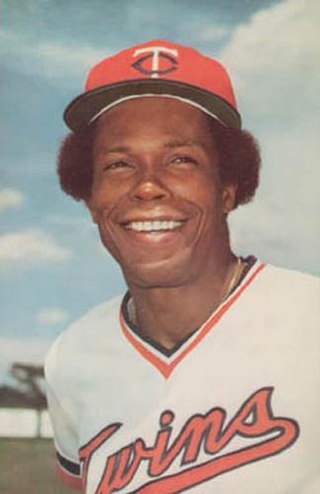Baseball statistics refers to a variety of metrics used to evaluate player and team performance in the game of baseball.

In baseball statistics, on-base percentage (OBP) measures how frequently a batter reaches base. An official Major League Baseball (MLB) statistic since 1984, it is sometimes referred to as on-base average (OBA), as it is rarely presented as a true percentage.
On-base plus slugging (OPS) is a sabermetric baseball statistic calculated as the sum of a player's on-base percentage and slugging percentage. The ability of a player both to get on base and to hit for power, two important offensive skills, are represented. An OPS of .800 or higher in Major League Baseball puts the player in the upper echelon of hitters. Typically, the league leader in OPS will score near, and sometimes above, the 1.000 mark.

In sports analytics, sabermetrics is the empirical analysis of baseball, especially baseball statistics that measure in-game activity. Sabermetricians collect and summarize the relevant data from this in-game activity to answer specific questions. The term is derived from the acronym SABR, which stands for the Society for American Baseball Research, founded in 1971. The term "sabermetrics" was coined by Bill James, who is one of its pioneers and is often considered its most prominent advocate and public face.

In baseball statistics, slugging percentage (SLG) is a measure of the batting productivity of a hitter. It is calculated as total bases divided by at-bats, through the following formula, where AB is the number of at-bats for a given player, and 1B, 2B, 3B, and HR are the number of singles, doubles, triples, and home runs, respectively:
Runs created (RC) is a baseball statistic invented by Bill James to estimate the number of runs a hitter contributes to their team.
Equivalent Average (EqA) is a baseball metric invented by Clay Davenport and intended to express the production of hitters in a context independent of park and league effects. It represents a hitter's productivity using the same scale as batting average. Thus, a hitter with an EqA over .300 is a very good hitter, while a hitter with an EqA of .220 or below is poor. An EqA of .260 is defined as league average.
In baseball, fielding independent pitching (FIP) is intended to measure a pitcher's effectiveness based only on statistics that do not involve fielders. These include home runs allowed, strikeouts, hit batters, walks, and, more recently, fly ball percentage, ground ball percentage, and line drive percentage. By focusing on these statistics and ignoring what happens once a ball is put in play, which – on most plays – the pitcher has little control over, DIPS claims to offer a clearer picture of the pitcher's true ability.
Tom Tango and "TangoTiger" are aliases used online by a baseball sabermetrics and ice hockey statistics analyst. He runs the Tango on Baseball sabermetrics website and is also a contributor to ESPN's baseball blog TMI . Tango is currently the Senior Database Architect of Stats for MLB Advanced Media.
Speed Score, often simply abbreviated to Spd, is a statistic used in Sabermetric studies to evaluate a baseball player's speed. It was invented by Bill James, and first appeared in the 1987 edition of the Bill James Baseball Abstract.

In baseball statistics, batting average on balls in play is a measurement of how often batted balls result in hits, excluding home runs. It can be expressed as, "when you hit the ball and it’s not a home run, what’s your batting average?" The statistic is typically used to evaluate individual batters and individual pitchers.
Base runs (BsR) is a baseball statistic invented by sabermetrician David Smyth to estimate the number of runs a team "should have" scored given their component offensive statistics, as well as the number of runs a hitter or pitcher creates or allows. It measures essentially the same thing as Bill James' runs created, but as sabermetrician Tom M. Tango points out, base runs models the reality of the run-scoring process "significantly better than any other run estimator".
The 1963 Los Angeles Dodgers were led by pitcher Sandy Koufax, who won both the Cy Young Award and the Most Valuable Player Award. The team went 99–63 to win the National League title by six games over the runner-up St. Louis Cardinals and beat the New York Yankees in four games to win the World Series, marking the first time that the Yankees were ever swept in the postseason.
In baseball, isolated power or ISO is a sabermetric computation used to measure a batter's raw power. One formula is slugging percentage minus batting average.
Wins Above Replacement or Wins Above Replacement Player, commonly abbreviated to WAR or WARP, is a non-standardized sabermetric baseball statistic developed to sum up "a player's total contributions to his team". A player's WAR value is claimed to be the number of additional wins his team has achieved above the number of expected team wins if that player were substituted with a replacement-level player: a player who may be added to the team for minimal cost and effort.
In baseball statistics, NERD is a quantitative measure of expected aesthetic value. NERD was originally created by Carson Cistulli and is part of his project of exploring the "art" of sabermetric research. The original NERD formula only took into account the pitcher's expected performance while a later model factors in the entire team's performance.
Out of zone plays made, known by the acronym OOZ, is a baseball statistic used to measure a baseball player's performance on defense.

On-base plus slugging plus runs batted in (OPSBI) is a baseball statistic calculated as the normalized sum of a player's on-base percentage and slugging percentage added to their runs batted in. Former Major League Baseball general manager, Jim Bowden, created this statistic. Hall of Fame outfielder, Babe Ruth, holds both the single-season and career OPSBI records.

Myles James Noble Straw is an American professional baseball center fielder in the Cleveland Guardians organization. He was drafted by the Houston Astros in the 12th round of the 2015 Major League Baseball draft, and made his major league debut with them in 2018. He has also played in MLB for the Guardians.







